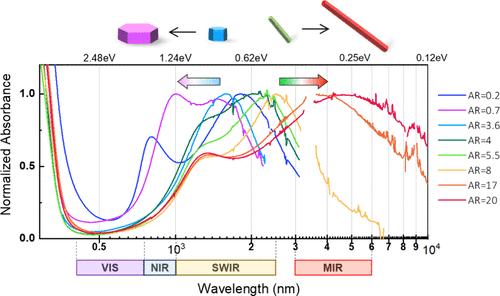等离子体CsxWO3−δ纳米晶体连续各向异性生长成棒状和片状
IF 16
1区 材料科学
Q1 CHEMISTRY, MULTIDISCIPLINARY
引用次数: 0
摘要
在纳米晶体合成过程中,形状控制可以在纳米尺度上实现可调的物理化学特性。虽然在控制各种系统(如等离子体金属纳米粒子或半导体量子点)的形状方面已经投入了大量的努力,但等离子体掺杂半导体纳米晶体的形状控制仍然很少被探索和限制。在这里,我们报道了CsxWO3−δ纳米晶体的合成,通过连续注射合成结合前体介导的面选择性生长,实现了精细的形状控制。研究表明,CsxWO3−δ纳米晶体的各向异性生长强烈依赖于前驱体注入速率,这归因于材料的固有结构各向异性和不同晶体学方面的对比反应动力学。此外,我们揭示了卤化物离子在反应介质中的存在是钝化和抑制cs暴露基面生长的关键。通过系统地调制形状长宽比,我们实现了纳米晶体形态的扩展范围,从而实现了LSPR光谱的广泛可调性,跨越整个近红外区域并延伸到中红外。计算模拟有效地再现了观察到的与形状相关的光学性质,并突出了与自由电子模型一致的与尺寸相关的阻尼行为。这些发现为结构各向异性纳米晶体的形状控制提供了强有力的实验方法,并为重掺杂等离子体半导体系统的可调谐LSPR特性提供了理论见解。本文章由计算机程序翻译,如有差异,请以英文原文为准。

Continuous Anisotropic Growth of Plasmonic CsxWO3−δ Nanocrystals into Rods and Platelets
Shape control during nanocrystal synthesis enables tunable physicochemical properties that emerge at the nanoscale. While extensive efforts have been devoted to controlling shapes in various systems such as plasmonic metal nanoparticles or semiconductor quantum dots, the shape control of plasmonic doped semiconductor nanocrystals remains less explored and limited. Here, we report the synthesis of CsxWO3−δ nanocrystals with exquisite shape control achieved through a continuous injection synthesis combined with precursor-mediated facet-selective growth. We demonstrate that the anisotropic growth of CsxWO3−δ nanocrystals is strongly dependent on the precursor injection rate, which we attribute to the material’s intrinsic structural anisotropy and the contrasting reaction kinetics on different crystallographic facets. Furthermore, we reveal that the presence of halide ions in the reaction medium is critical for passivating and suppressing the growth of Cs-exposed basal planes. By systematically modulating the shape aspect ratio, we achieved an extended range of nanocrystal morphologies, leading to a broad tunability of LSPR spectra, spanning the entire near-infrared region and extending into the mid-infrared. Computational simulations effectively reproduce the observed shape-dependent optical properties and highlight the size-dependent damping behavior consistent with the free electron model. These findings provide a robust experimental methodology for shape control in structurally anisotropic nanocrystals and offer theoretical insights into the tunable LSPR properties of heavily doped plasmonic semiconductor systems.
求助全文
通过发布文献求助,成功后即可免费获取论文全文。
去求助
来源期刊

ACS Nano
工程技术-材料科学:综合
CiteScore
26.00
自引率
4.10%
发文量
1627
审稿时长
1.7 months
期刊介绍:
ACS Nano, published monthly, serves as an international forum for comprehensive articles on nanoscience and nanotechnology research at the intersections of chemistry, biology, materials science, physics, and engineering. The journal fosters communication among scientists in these communities, facilitating collaboration, new research opportunities, and advancements through discoveries. ACS Nano covers synthesis, assembly, characterization, theory, and simulation of nanostructures, nanobiotechnology, nanofabrication, methods and tools for nanoscience and nanotechnology, and self- and directed-assembly. Alongside original research articles, it offers thorough reviews, perspectives on cutting-edge research, and discussions envisioning the future of nanoscience and nanotechnology.
 求助内容:
求助内容: 应助结果提醒方式:
应助结果提醒方式:


